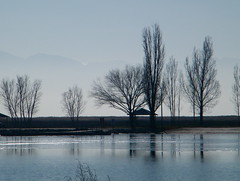Thursday, June 24, 2010
Saturday, June 12, 2010
Oil Spill in Salt Lake City Affects Wildlife
This is awful! I will be staying on top of this if any further assistance is needed!
From the Associated Press -
From the Associated Press -
SALT LAKE CITY (AP) - A leaked pipeline sent oil spilling into a Salt Lake City creek, coating geese and ducks and closing a park, officials said Saturday as they started a cleanup effort expected to last weeks.
At least 400 to 500 barrels of oil spewed into Red Butte Creek before crews capped the leak site. Nearly 50 gallons of crude oil per minute initially had spilled into the creek, according to Scott Freitag, a Salt Lake City Fire Department spokesman.
Labels:
Associated Press,
Liberty Park,
Oil Spill,
Salt Lake City
Wednesday, June 9, 2010
Wine 101 Article from Snooth
It is always good to review the basics in wine, I find so I am reprinting this article from Snooth! Cheers!
 We all love wine, but do we really understand what wine is? Sure, in its purest form, it’s grape juice gone “bad," but there are additional elements in even the simplest of wines. With today's winemaking tools, you can be sure there's so much more to a bottle than fruit and time.
We all love wine, but do we really understand what wine is? Sure, in its purest form, it’s grape juice gone “bad," but there are additional elements in even the simplest of wines. With today's winemaking tools, you can be sure there's so much more to a bottle than fruit and time.
While enjoying a bottle of wine can be simple, understanding wine (good wine, at least) can be quite complex. Today, I want to get the ball rolling on a series of educational emails that will focus on all aspects of wine appreciation, beginning with the basics of winemaking, and then moving along to understanding specific wines and wine-producing regions.
At its core, wine is composed of water, alcohol, aromatic compounds, acids, and tannins. In this overview, we’ll take a look at what everything is and where it might come from. You might be surprised at some of the answers.
Enzymes are added to fermenting wine to help prevent the growth of bad yeasts that can cause wine spoilage. There are even enzymes that improve the formation of sediment in young wines, allowing for better filtering, and thus leading to higher yields.
Polysaccharides are added to promote the retention of color, tannin, and flavoring compounds extracted from grape skins.
Gum Arabic is added to wine to lock in the aromatic compounds in a wine, but it also adds a richness to the mouthfeel, which has become its main propose.
Sulfur products are used as a anti-oxidative preservative in wine. These are products that have long histories in winemaking, and are actually one of the wine additives that we’re seeing less, not more, of as winemakers develop a better understanding of what a sufficient dose of SO2 is.



 Gregory Dal Piaz is a proponent and admirer of a broad range of wines and styles. During his decades of collecting and tasting he has discovered that a wine need not cost a fortune to drink well. Feel free to ask him questions at the Snooth Forums where he regularly engages with beginners and experts alike.
Gregory Dal Piaz is a proponent and admirer of a broad range of wines and styles. During his decades of collecting and tasting he has discovered that a wine need not cost a fortune to drink well. Feel free to ask him questions at the Snooth Forums where he regularly engages with beginners and experts alike.
Wine 101: What is Wine?
Learn the science behind your favorite bottle
 We all love wine, but do we really understand what wine is? Sure, in its purest form, it’s grape juice gone “bad," but there are additional elements in even the simplest of wines. With today's winemaking tools, you can be sure there's so much more to a bottle than fruit and time.
We all love wine, but do we really understand what wine is? Sure, in its purest form, it’s grape juice gone “bad," but there are additional elements in even the simplest of wines. With today's winemaking tools, you can be sure there's so much more to a bottle than fruit and time. While enjoying a bottle of wine can be simple, understanding wine (good wine, at least) can be quite complex. Today, I want to get the ball rolling on a series of educational emails that will focus on all aspects of wine appreciation, beginning with the basics of winemaking, and then moving along to understanding specific wines and wine-producing regions.
At its core, wine is composed of water, alcohol, aromatic compounds, acids, and tannins. In this overview, we’ll take a look at what everything is and where it might come from. You might be surprised at some of the answers.
1.) Grapes
Well, duh. Of course wines start with grapes, some even end with grapes, since the yeast needed to convert the grapes' sugar to alcohol is frequently found lurking on the skin of each berry. White grapes make white wines -- of course, white grapes are usually green or yellow, and some are even pink or red. Extremely few grapes actually have red flesh, so the color of the grape refers to its skin color. You can make white wines from red grapes, as well as Rose and red wine, of course.2.) Yeast
The yeast cells turn delicious, sweet grape juice into wine. They eat sugar and produce alcohol as a by-product. Many vineyards like to use indigenous yeasts -- those found on the grapeskins themselves -- as each vintage can bring a different combination of yeast strains, which may allow for more distinctive and complex wines. Most wineries, though, use cultivated, or commercial yeasts. There is a distinction, however: As some wineries find that a specific yeast that was indigenous to their vines produced a better than average result, the winery may begin to cultivate the yeast. Most wineries that use truly commercial yeasts use them because they are efficient and tolerant of high-alcohol environments (aka the Achilles' heel of many indigenous yeasts; it can lead to what are known as stuck, or incomplete fermentations.)3.) Acid
Acid is the part of wine that makes you smack your lips and leaves your mouth watering. It’s a vital component of deliciousness in wine. Acid is naturally occurring in all fruit, and we know from making lemonade that there is a subjectively ideal balance that can be achieved between sweetness and acidity. Even in a dry wine there are flavors that we can perceive as sweet (alcohol also can give an impression of sweetness), so having the right amount of acid in a wine is crucial. Grapes are born with primarily hard Malic and Tartaric acids, though many whites and most reds go through a secondary, bacterial fermentation (as opposed to yeast-driven) that converts the acid of green apples (Malic acid) to the softer acid of fermented dairy products such as yogurt (lactic acid). As grapes ripen, sugars increase and acids tend to decrease, so some winemakers routinely add additional acid to their wines. The most common acids used in acidification are Tartaric acid, Malic acid and citric acid. Some wines are also de-acidified by adding specific salts that can precipitate out tartaric acids.4.) Tannins
Tannins come from the seeds and skins of grapes -- and stems, too if they’re added into to the fermenting must -- as well as from wooden barrels that can be used to age wines. The tannin in wines acts as a preservative and, along with acidity, is referred to as the structure of a wine. Tannins make your mouth pucker, your gums feel fuzzy, and your mouth feel dry. You can probably see already that having the right balance between drying tannins and mouthwatering acids is pretty important. The tannins in fruit and the tannins from wood are a bit different, but it’s hard to tell them apart and they pretty much do the same thing, so I’ll save that exercise for another time. Tannins can also be added to wines in powder form.5.) Additives
This is the dirty truth about modern winemaking. There is a laundry list of additives, some with long historical roots, others recent additions to the winemaker’s medicine cabinet, all of which can be used to “improve” wines. Of course you might ask yourself why wines need so much “improving,” since for thousands of years folks have been making some pretty good hootch with just grapes and a bucket, but that’s a discussion for another day. Here's a brief rundown of what else might be lurking in your next glass of wine.Enzymes are added to fermenting wine to help prevent the growth of bad yeasts that can cause wine spoilage. There are even enzymes that improve the formation of sediment in young wines, allowing for better filtering, and thus leading to higher yields.
Polysaccharides are added to promote the retention of color, tannin, and flavoring compounds extracted from grape skins.
Gum Arabic is added to wine to lock in the aromatic compounds in a wine, but it also adds a richness to the mouthfeel, which has become its main propose.
Sulfur products are used as a anti-oxidative preservative in wine. These are products that have long histories in winemaking, and are actually one of the wine additives that we’re seeing less, not more, of as winemakers develop a better understanding of what a sufficient dose of SO2 is.
6.) Fining agents
Once upon a time wines were fined (think of it as filtering, but with the filtering drifting down through the wine as opposed to the wine being forced through a physical filter) with ox blood and egg whites. (Learn more about the ancient history of wine in our series on early winemaking practices.) While egg albumin is still a common fining agent, it has been joined by things like bentonite clay, gelatin, and even silica. There is no actual residue left from proper fining, so don’t look for chunks in your glass (sediment in wines is something entirely different, and we’ll talk about that next time.)
What makes a wine's structure?
Tannins come from grape seeds and skins, as well as from the oak barrels used to age wine. They give wine an astringent bite, and protect the fruit from oxygen.

Acid comes in many forms, but they all help give wine its mouth-watering zing. Red and white wines are sometimes treated differently to achieve proper balance.

Original Post: http://www.snooth.com/articles/commentary/wine-101-what-is-wine/?utm_campaign=1031&utm_medium=email&utm_source=all&utm_content=2328
About the Author
 Gregory Dal Piaz is a proponent and admirer of a broad range of wines and styles. During his decades of collecting and tasting he has discovered that a wine need not cost a fortune to drink well. Feel free to ask him questions at the Snooth Forums where he regularly engages with beginners and experts alike.
Gregory Dal Piaz is a proponent and admirer of a broad range of wines and styles. During his decades of collecting and tasting he has discovered that a wine need not cost a fortune to drink well. Feel free to ask him questions at the Snooth Forums where he regularly engages with beginners and experts alike.Saturday, June 5, 2010
Friday, June 4, 2010
Sassy Scoops - Do you Follow the Sassies?
Since arriving in Utah, I have found the Social Media community to be fun, warm and inclusive - one of the many reasons that I love my new home state!
Some of the really fun ladies are the Sassies - they have great giveaways, awesome local features and the Sassies individually have wonderful blogs. Connect with them at SassyScoops.com!
As part of one of their many giveaways, running through June 12, if you create a blog post about Sassy Scoops.com and add their widget to your blog, you are entered to win $100 in gift cards to support local businesses. Can you say WIN WIN? Enter the contest here!
Beehive Blog is all in for this and to support Sassy Scoops - some of our local best! GO Sassies!

Some of the really fun ladies are the Sassies - they have great giveaways, awesome local features and the Sassies individually have wonderful blogs. Connect with them at SassyScoops.com!
As part of one of their many giveaways, running through June 12, if you create a blog post about Sassy Scoops.com and add their widget to your blog, you are entered to win $100 in gift cards to support local businesses. Can you say WIN WIN? Enter the contest here!
Beehive Blog is all in for this and to support Sassy Scoops - some of our local best! GO Sassies!

Labels:
Contest,
Giveaways,
Sassy Scoops,
Shakti,
Social Media,
Utah
Fab Friday Finds! Check out these Recipes & Blogs
I had a bit of a lazy cooking week and whenever I need inspiration, I tiptoe through the Foodies Unite and find some new recipes to try in the upcoming week. I am also nosy and I love to see what everyone is up to!
Fab Friday Finds - Foodies Unite Recommends! Let them know Foodies Unite sent you!
Cookin' Canuck - Wild Mushroom & Cornbread Panzanella Salad Recipe - Drool worthy - Dara has a great blog with tons of yummy recipes!
Fab Friday Finds - Foodies Unite Recommends! Let them know Foodies Unite sent you!
Cookin' Canuck - Wild Mushroom & Cornbread Panzanella Salad Recipe - Drool worthy - Dara has a great blog with tons of yummy recipes!
Country Ribs without Barbecue Sauce
I have an issue when it comes to ribs - I can't stand most barbecue sauces. I am always on the search for good rib recipes that are creative and yummy. So, when I saw the boneless country ribs on sale at the store, I could not resist and then got home and had a "what now?" moment.
I decided to boil the ribs in a big pot. I covered the ribs (a little over 1.5 pds) in water and added the following to the pot:
8 cloves of crushed garlic
1 TB crushed rosemary
1 TB oregano
handful of chopped cilantro (use 3/4 in the pot)
1 lime juiced
1/4 cup worcestershire sauce
salt
ground black pepper
Bring to a boil, then simmer uncovered over medium heat until the water has completely evaporated, about 25 minutes. Slow cook a bit longer for even more tender meat!
When all of the water is gone, brown the meat, turning occasionally. Use a spatula to scrape up browned bits and softened garlic from the bottom of the pot, and toss them with the pork. The garlic will dissolve onto the meat. Remove the meat, and drain on paper towels.
Season with black pepper and garnish with lime wedges and remaining cilantro.
I served the pork with black beans and rice - super yummy and a great replacement for the Barbecue. After boiling - you can always throw them on the grill for a few minutes instead of browning on the stove!
I decided to boil the ribs in a big pot. I covered the ribs (a little over 1.5 pds) in water and added the following to the pot:
8 cloves of crushed garlic
1 TB crushed rosemary
1 TB oregano
handful of chopped cilantro (use 3/4 in the pot)
1 lime juiced
1/4 cup worcestershire sauce
salt
ground black pepper
Bring to a boil, then simmer uncovered over medium heat until the water has completely evaporated, about 25 minutes. Slow cook a bit longer for even more tender meat!
When all of the water is gone, brown the meat, turning occasionally. Use a spatula to scrape up browned bits and softened garlic from the bottom of the pot, and toss them with the pork. The garlic will dissolve onto the meat. Remove the meat, and drain on paper towels.
Season with black pepper and garnish with lime wedges and remaining cilantro.
I served the pork with black beans and rice - super yummy and a great replacement for the Barbecue. After boiling - you can always throw them on the grill for a few minutes instead of browning on the stove!
Subscribe to:
Posts (Atom)















![Reblog this post [with Zemanta]](http://img.zemanta.com/reblog_e.png?x-id=17d34980-2a2b-4bd2-af77-a9e8fa7662b3)

![Reblog this post [with Zemanta]](http://img.zemanta.com/reblog_e.png?x-id=9cdabf45-6ee0-4b4b-ae0a-0d9093893440)